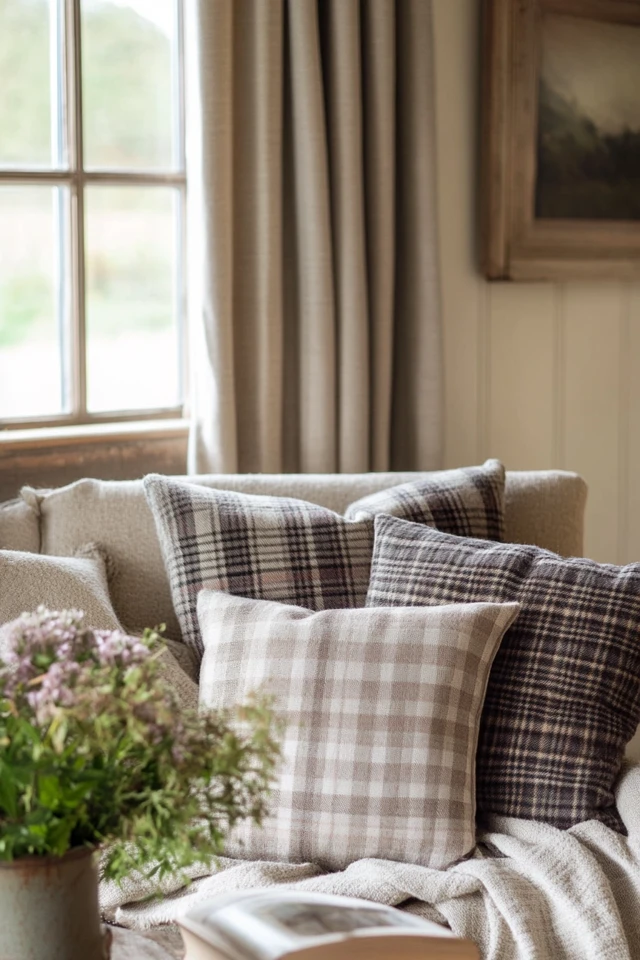Introduction
Plaid is more than just a classic pattern—it’s a design staple that evokes warmth, nostalgia, and rustic charm. When paired with farmhouse interiors, plaid becomes a versatile and timeless element that enhances the cozy, lived-in feel of the space. Whether it’s on throw pillows, upholstered furniture, curtains, or even area rugs, plaid brings character and texture to your home, making it feel inviting and full of personality.
My love affair with plaid began when I inherited a vintage armchair with a faded plaid print from my grandmother. At first, I wasn’t sure how it would fit into my modern farmhouse-style living room, but I decided to keep it. To my surprise, it became the focal point of the space. I started incorporating plaid in small, intentional ways—like throw blankets and a set of plaid kitchen towels—and before long, I realized how effortlessly it tied everything together. Now, plaid is one of my favorite patterns to use when designing cozy, farmhouse-inspired spaces.
If you’ve been curious about how to incorporate plaid patterns into your farmhouse interiors, this guide will show you everything you need to know. From selecting the right color palette to balancing plaid with other design elements, we’ll explore ways to embrace this timeless pattern without overwhelming your space.
The Perfect Design for You
Plaid is perfect for farmhouse interiors because it captures the essence of rustic simplicity and warmth. Its structured pattern complements the natural textures and neutral tones often found in farmhouse design, while its timeless appeal ensures it never goes out of style.
The beauty of plaid lies in its versatility. Whether you’re drawn to traditional tartans, buffalo checks, or understated ginghams, there’s a plaid pattern to suit every taste. Imagine a cozy farmhouse living room with a plaid throw draped over a slipcovered sofa, a dining room featuring plaid seat cushions, or a bedroom with a plaid duvet as the focal point. Plaid can be as bold or as subtle as you want, making it easy to adapt to your personal style.
With the right approach, plaid can elevate your farmhouse interiors, adding depth, texture, and a touch of nostalgia to every room.
Picture Gallery
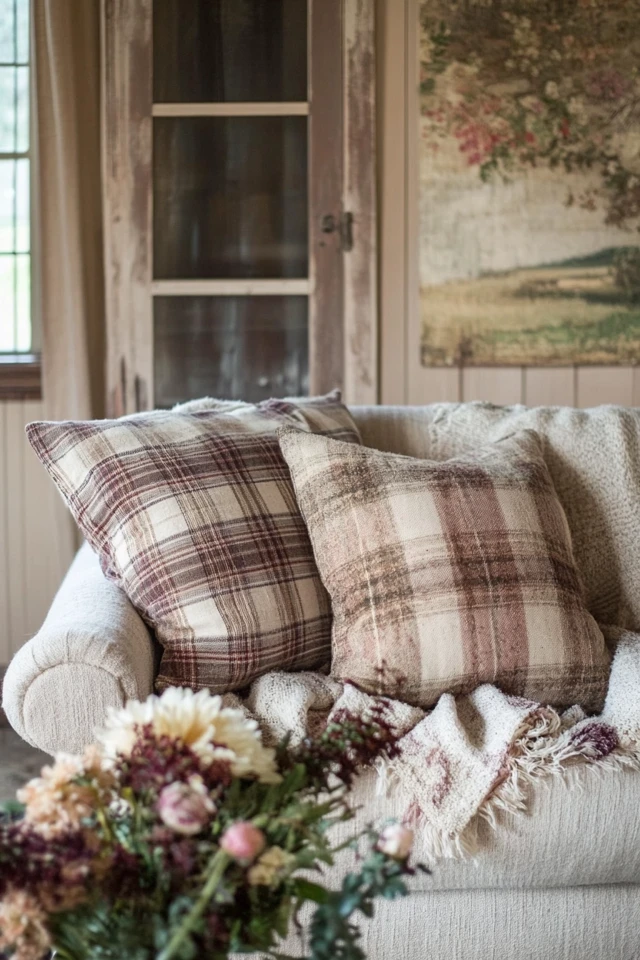
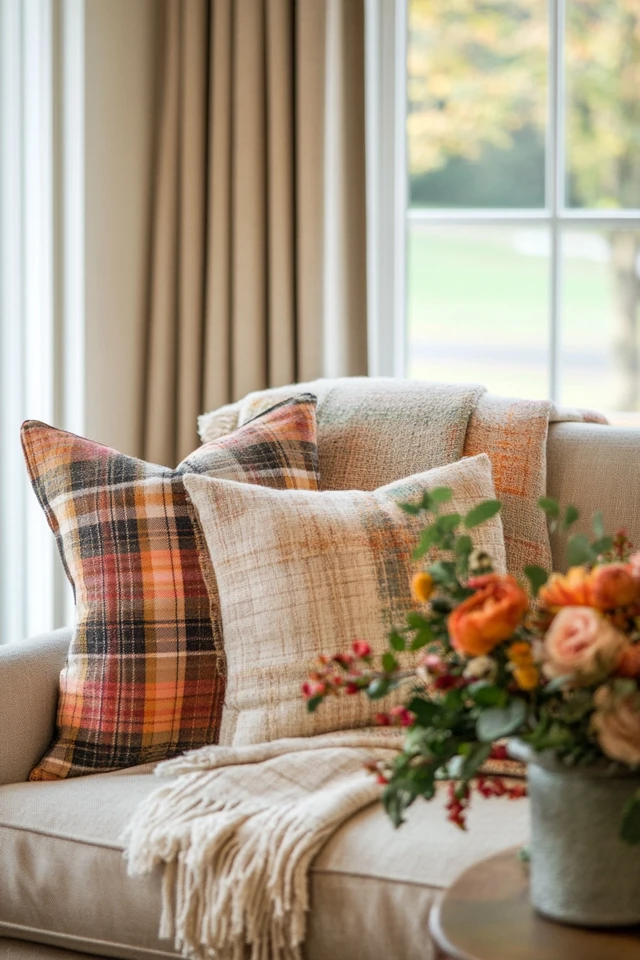
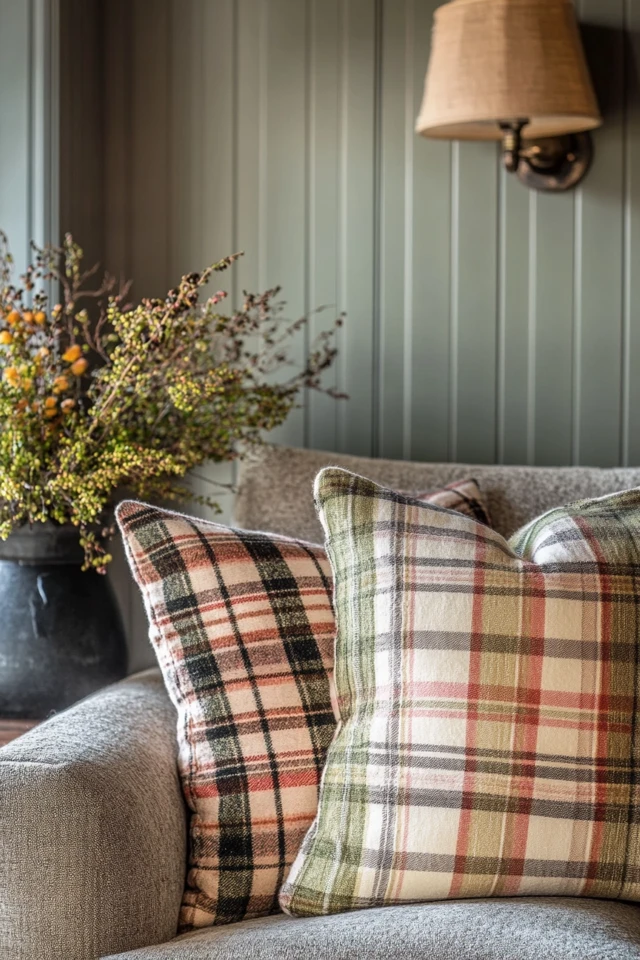
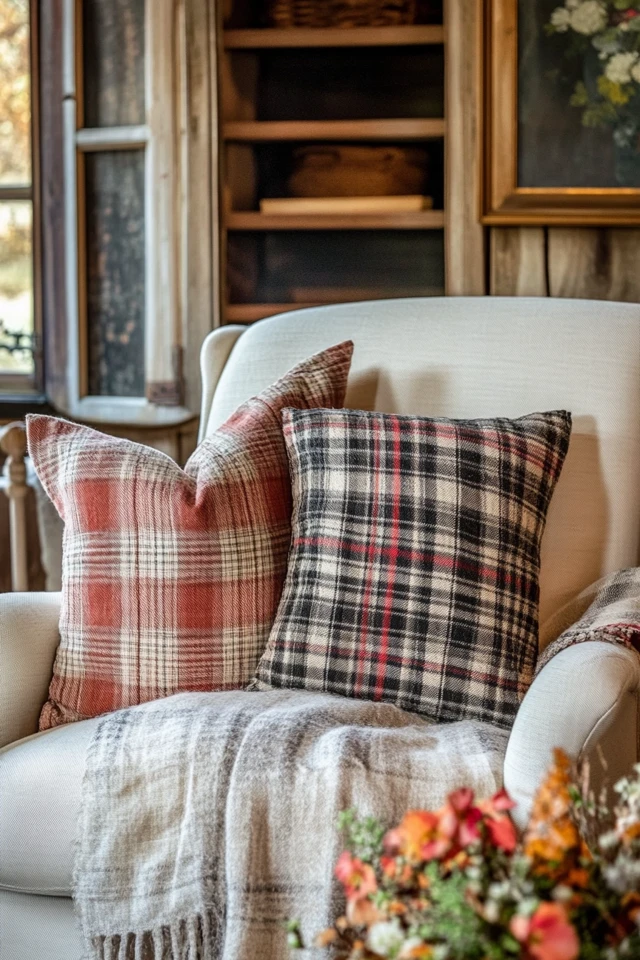
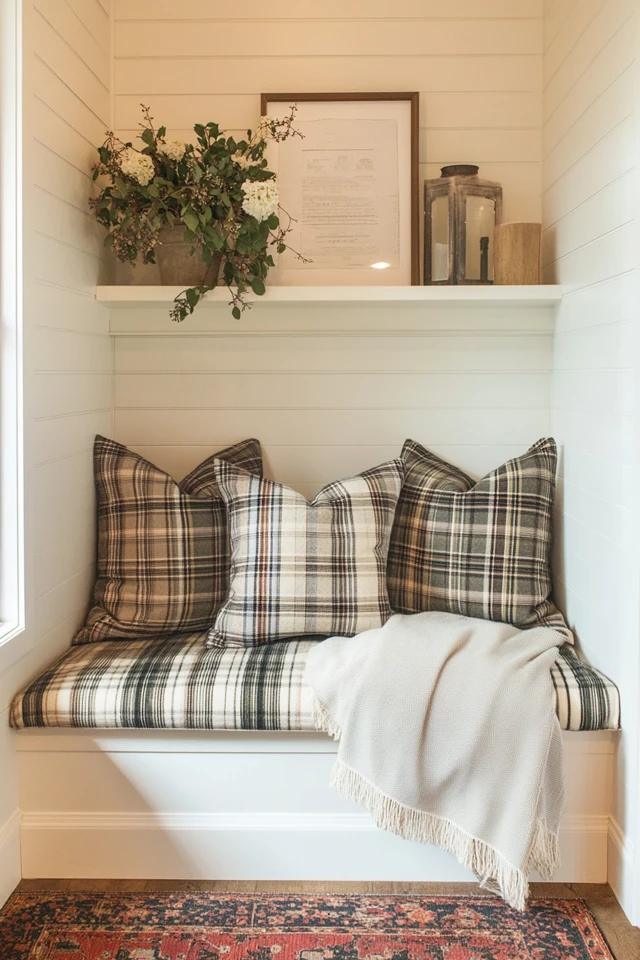
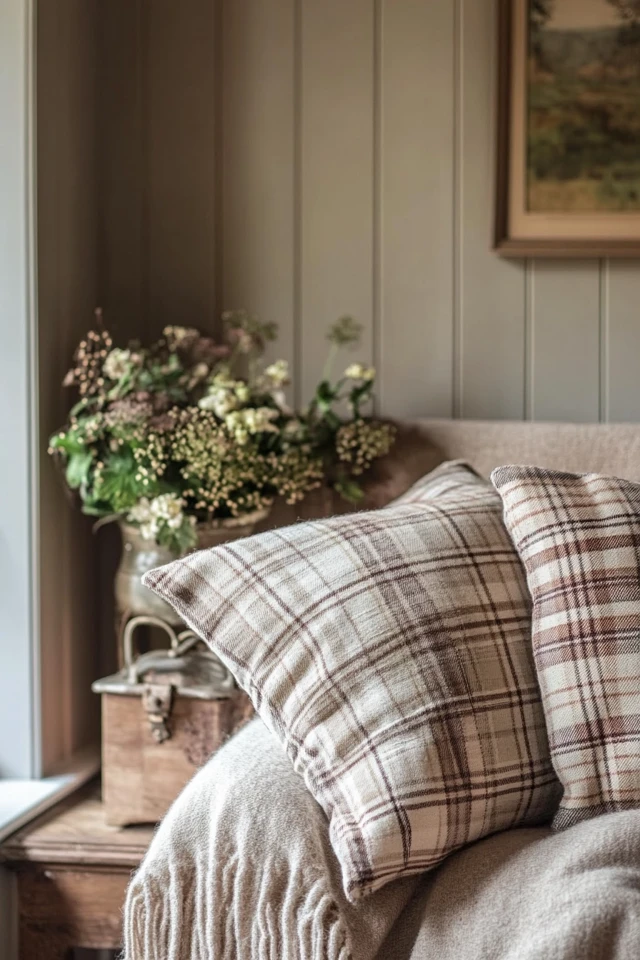
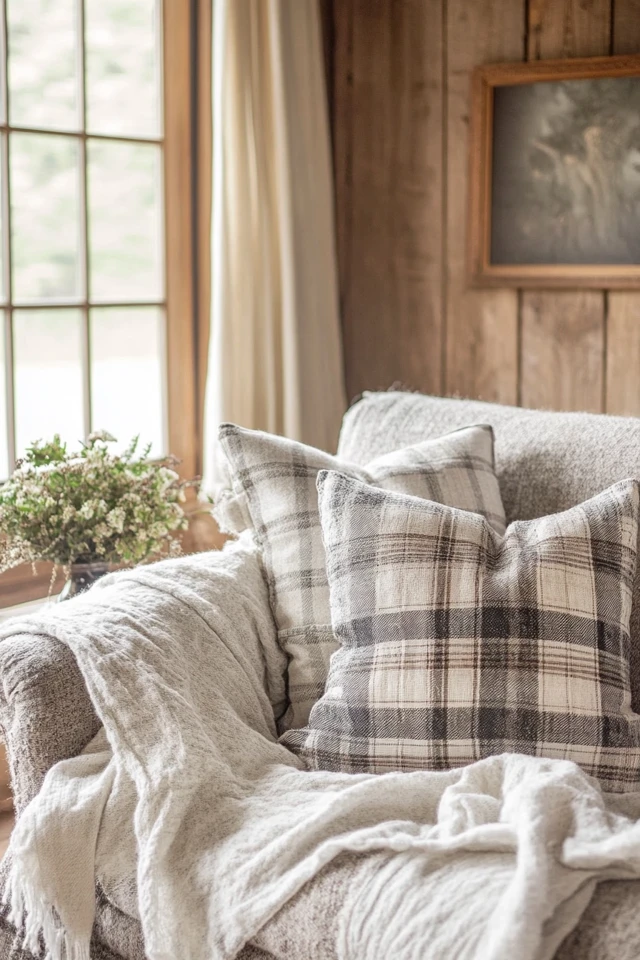
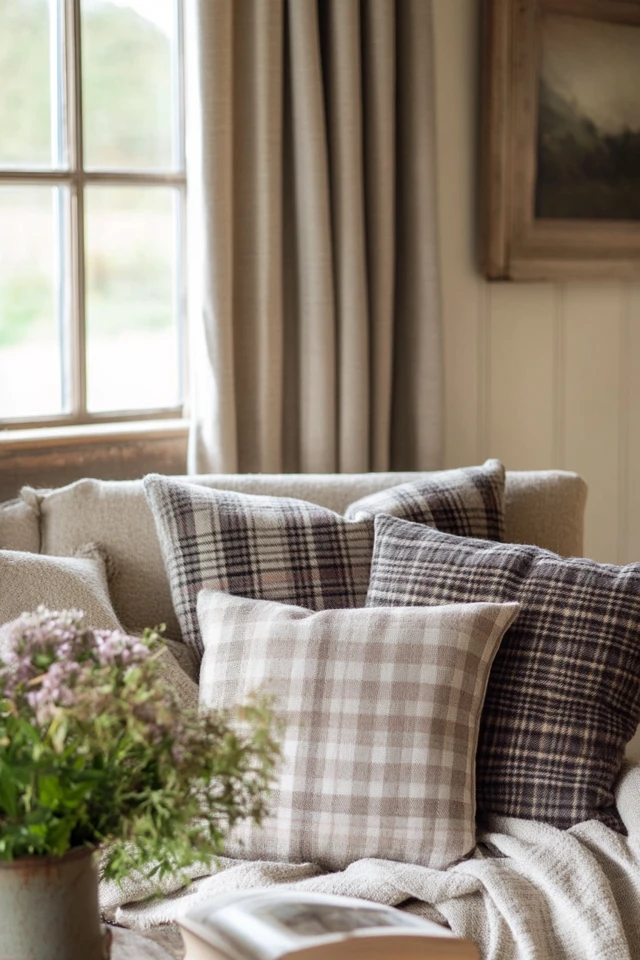
Why These Key Elements Work So Well Together
Plaid patterns work beautifully in farmhouse interiors because they balance structure and charm while enhancing the overall aesthetic. Here’s why plaid is such a perfect match for farmhouse design:
- Timeless Appeal: Plaid is a pattern with deep historical roots, making it a classic choice that feels right at home in farmhouse spaces.
- Neutral Palette Compatibility: Plaid’s muted tones, often in greys, whites, blacks, and earth tones, complement the soft, natural hues of farmhouse interiors.
- Rustic Charm: The pattern’s rustic origins pair seamlessly with other farmhouse staples like wood, linen, and galvanized metal.
- Versatility: Plaid can be used in bold statement pieces or as subtle accents, making it easy to layer into any room.
- Visual Texture: The grid-like structure of plaid adds depth and interest to a space without feeling overwhelming.
How to Incorporate Plaid Patterns Into Farmhouse Interiors
1. Start Small with Accessories
- Throw Pillows: Add plaid throw pillows to sofas, armchairs, or beds for a quick and easy way to introduce the pattern.
- Throw Blankets: Drape a plaid blanket over the back of a chair, sofa, or bench for a cozy touch.
- Table Linens: Use plaid tablecloths, runners, or napkins to bring a subtle pattern to your dining area.
- Kitchen Towels: Hang plaid dish towels or oven mitts for a functional yet decorative element in the kitchen.
2. Incorporate Upholstery
- Plaid Armchairs or Sofas: A plaid-upholstered armchair or loveseat can act as a statement piece in your living room.
- Dining Chairs: Add plaid seat cushions or upholstered dining chairs for a farmhouse-style dining room.
- Ottomans or Benches: Use plaid fabric on ottomans, poufs, or entryway benches for a cozy, textured look.
3. Layer Plaid in Bedding
- Duvet Covers: Choose a plaid duvet cover or quilt as the focal point of your bedroom.
- Accent Pillows: Layer plaid pillows with solid or striped ones to create depth and visual interest.
- Blankets: Add a plaid blanket or bed scarf at the foot of the bed for extra warmth and style.
4. Use Plaid Curtains and Drapes
- Hang plaid curtains in living rooms, kitchens, or bedrooms to bring pattern to your windows.
- For a lighter look, opt for plaid cafe curtains or valances.
- Pair plaid drapes with neutral walls to keep the space feeling balanced.
5. Incorporate Rugs
- A plaid area rug can anchor a farmhouse living room or dining area.
- Use smaller plaid rugs in entryways, kitchens, or bathrooms for a pop of pattern.
- Stick to neutral tones for rugs to ensure they complement the rest of the decor.
6. Mix Plaid with Other Patterns
- Combine plaid with stripes, florals, or solids to create a layered and dynamic look.
- Stick to a cohesive color palette to keep the patterns from clashing.
- Use plaid as the dominant pattern and layer in smaller-scale prints for balance.
7. Add Seasonal Plaid Touches
- Fall: Use warm, autumnal plaids in oranges, browns, and deep reds for a cozy seasonal update.
- Winter: Incorporate festive plaid patterns like red and green tartans for holiday decor.
- Spring and Summer: Opt for lighter plaids in pastel or neutral tones to brighten up your space.
8. Use Plaid in Unexpected Places
- Wallpaper: Create an accent wall with plaid wallpaper for a bold farmhouse statement.
- Stair Risers: Add plaid decals or fabric to stair risers for a unique touch.
- Cabinet Liners: Line the inside of cabinets or drawers with plaid-patterned paper for a subtle detail.
FAQ Section
1. Can I mix different plaid patterns in the same room?
Yes! Mixing plaid patterns can create a dynamic look, but be sure to stick to a cohesive color palette to keep the design balanced. Vary the scale of the patterns (e.g., a large buffalo check with a smaller gingham) for contrast.
2. Is plaid only suitable for rustic farmhouse interiors?
Not at all! While plaid is a natural fit for rustic and traditional farmhouse styles, it can also work in modern farmhouse or even eclectic interiors when paired with clean lines and contemporary elements.
3. What colors work best for farmhouse plaid?
Neutral tones like black, white, grey, beige, and muted earth tones are classic choices. Seasonal colors like red and green or soft pastels can also work beautifully.
4. How do I prevent plaid from overwhelming my space?
Use plaid in moderation by starting with small accents or layering it with solid colors and textures. Keep the rest of the decor simple to let the plaid stand out without feeling too busy.
5. Where can I find farmhouse-style plaid decor?
Look for plaid items at home decor stores, vintage shops, or online retailers like Etsy and Amazon. Thrift stores are also great places to find unique plaid pieces.
Variations
- Modern Farmhouse Plaid: Stick to black-and-white buffalo checks or neutral-toned plaids for a clean, contemporary look.
- Rustic Farmhouse Plaid: Use warm, earthy plaids with distressed wood and vintage-inspired accents for a traditional feel.
- Coastal Farmhouse Plaid: Incorporate light blue and white ginghams for a breezy, seaside vibe.
- Boho Farmhouse Plaid: Mix plaid with colorful patterns and macramé accents for a playful, eclectic style.
- Industrial Farmhouse Plaid: Pair bold black-and-white plaids with metal accents and reclaimed wood for an edgier aesthetic.
How to Showcase It
- Seasonal Displays: Style plaid pillows and blankets on your sofa or porch swing for festive fall or winter decor.
- Cozy Corners: Create a reading nook with a plaid-upholstered armchair, a soft throw, and a vintage lamp.
- Social Media-Worthy Bedrooms: Share photos of your layered plaid bedding and rustic accents for an Instagram-ready look.
Occasions to Feature It
- Holiday Gatherings: Use plaid table runners, napkins, or stockings to bring a festive farmhouse vibe to your celebrations.
- Everyday Comfort: Incorporate plaid throw pillows and blankets to make your living spaces feel warm and inviting year-round.
- Seasonal Refreshes: Swap out plaid decor in lighter or darker tones to match the changing seasons.
Conclusion
Plaid is a timeless pattern that brings warmth, texture, and character to farmhouse interiors. From subtle accents to bold statement pieces, incorporating plaid into your decor is a simple way to create a cozy, inviting atmosphere.
Whether you’re updating your living room, bedroom, or dining area, plaid offers endless possibilities for adding charm and style to your space. Start small, experiment with patterns and colors, and watch how this classic design element transforms your farmhouse interiors into a haven of comfort and beauty.

